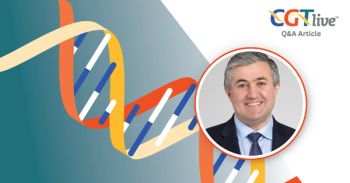
Breakthrough T-Cell Therapy Halts EBV-Associated Lymphoproliferative Disorders
Infusions of Epstein-Barr virus (EBV)–specific cytotoxic T lymphocytes from healthy donors led to high response rates and significant extensions in overall survival for patients with rituximab-refractory EBV–associated lymphoproliferative disorders.
Richard J. O'Reilly, MD
Infusions of Epstein-Barr virus (EBV)—specific cytotoxic T lymphocytes (CTLs) from healthy donors led to high response rates and significant extensions in overall survival (OS) for patients with rituximab-refractory EBV—associated lymphoproliferative disorders (LPD), according to findings from two clinical trials presented at the 2015 AACR Annual Meeting.
In the two studies, the objective response rate (ORR) was over 60% in patients treated with EBV-CTLs derived from either unrelated or primary stem cell donors. Furthermore, the median response duration with the novel T-cell therapy was 318 days. In patients refractory to prior therapy with rituximab, the 1-year OS rate was approximately 50%.
“In the absence of effective therapy, these patients have an average survival time of only 16 to 56 days," senior study author Richard J. O’Reilly, MD, chief of the Pediatric Bone Marrow Transplantation Service at Memorial Sloan Kettering Cancer Center (MSK), said in a statement. "The good news from our two clinical trials is that EBV-CTLs–generated from either the patient’s transplant donor or from the bank of normal donor T cells developed at Memorial Sloan Kettering–put aggressive EBV-LPD that had failed to respond to rituximab into long-lasting remission in more than 60% of patients."
EBV reactivation can occur following allogeneic hematopoietic stem cell transplantation, causing significant morbidity and mortality if T lymphocyte activity is not reconstituted. Strategies for the early detection of EBV-LPD have been developed, such as serial measurements of EBV-DNA load, warranting a distinct treatment strategy.
On March 5, 2015, the MSK EBV-CTLs derived from third party donors received a breakthrough therapy designation from the FDA as a treatment for patients with rituximab-refractory EBV-LPD. In the two ongoing clinical trials presented at AACR that were the basis for this designation, 57 patients were treated with EBV-CTLs (31 from unrelated donors and 26 from primary donors).
The first trial, labeled 11-130, contained 18 rituximab-refractory patients at a median age of 52 years. The second study, known as 95-024, enrolled 39 patients at a median age of 21 years. Of these patients, 28 had failed prior rituximab (72%). The majority of patients (90%) had monomorphic diffuse large B-cell lymphoma.
The T lymphocytes for the therapy were collected from EBV-immune donors. Prior to treatment, lymphocytes were expanded in a culture and stimulated to respond to multiple EBV proteins, according to O’Reilly. In both studies, patients received up to 5 cycles of EBV-CTLs. Each 3-week cycle consisted of a weekly infusion of 1 or 2x106 cells/kg.
In the phase II 11-130 trial, the ORR was 57%, with a complete response (CR) rate of 50% and a partial response rate of 17%. Additionally, 5% of patients had stable disease (SD), for a clinical benefit rate (CBR) of 72%. The OS rate at 1 and 2 years was 71.8%. The progression-free survival rate at 1-year was 66.7%.
In the phase I/II 95-024 study, which was initiated in 1995, the ORR was 62%, with a CR rate of 59% and a PR rate of 3%. The SD rate was 8%, for a CBR of 69%. Of the patients who achieved a CR with EBV-CTL therapy, 35% were alive at 5 years. One patient was alive more than 10 years follow treatment, according to O’Reilly.
In rituximab-refractory patients across both studies (n = 46), the 1-year OS was 50% with EBV-CTLs from third-party donors and 49% with primary donor lymphocytes.
“The EBV-CTLs work well for the majority of recipients. However, the responses became clinically evident only after the T cells expanded in vivo, which took about seven to 14 days," O’Reilly explained.
Treatment with the EBV-CTLs was well tolerated, with a low toxicity profile. No patients on the trial developed cytokine release syndrome or graft-versus-host disease.
"We are rigorously pursuing the development of biomarkers or other tests to predict response earlier,” said O’Reilly. “We are looking forward to working with our collaborators at Atara Biotherapeutics and regulators to plan the next steps.”
Both studies presented at AACR remain open to enrollment. The 11-130 trial continues to explore treatment with EBV-CTLs for patients with EBV-LPD, and is currently recruiting participants at MSK. The primary endpoint will assess responses at 3 weeks post-infusion cycle, with a secondary outcome measure focused on complete remission. The target enrollment for the study is 112 patients (NCT01498484).
Prockop SE, Doubrovina E, Baroudy K, et al. Epstein-Barr virus (EBV)-specific cytotoxic T lymphocytes (EBV-CTLs) for treatment of rituximab-refractory EBV-associated lymphoproliferative disorder (EBV-LPD). Presented at: 2015 AACR Annual Meeting; April 18-22, 2015; Philadelphia, PA. Abstract 8841.
<<<
Newsletter
Stay at the forefront of cutting-edge science with CGT—your direct line to expert insights, breakthrough data, and real-time coverage of the latest advancements in cell and gene therapy.
















































